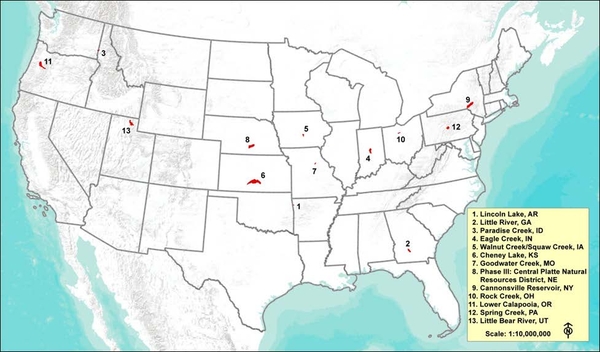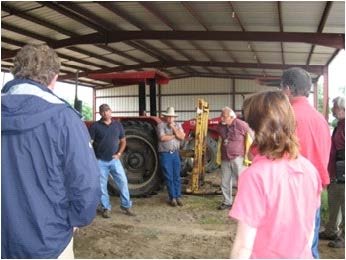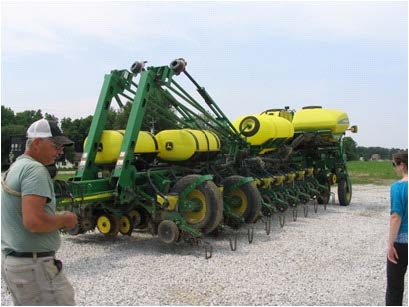NIFA Conservation Effects Assessment Project (CEAP)
Watershed Assessment Studies
Lessons Learned from the National Institute of Food and Agriculture (NIFA)-CEAP Synthesis Fact Sheet 3
Thirteen agricultural watershed projects were funded jointly by the USDA National Institute of Food and Agriculture (NIFA) and Natural Resources Conservation Service (NRCS) to evaluate the effects of cropland and pastureland conservation practices on spatial and temporal trends in water quality at the watershed scale. In some projects, participants also investigated how social and economic factors influence implementation and maintenance of practices. The 13 projects were conducted from 2004 to 2011 as part of the overall Conservation Effects Assessment Project (CEAP). The NIFA-CEAP projects were mainly retrospective; most conservation practices and water quality monitoring efforts were implemented through programs that occurred before the NIFA-CEAP projects began. By synthesizing the results of all these NIFA-CEAP projects, we explore lessons learned about the social and economic factors within the watersheds that either facilitated or impeded implementation and proper maintenance of conservation practices.
Why Do Farmers Adopt Conservation?
Ultimately, conservation practices only work if they are adopted. As one farmer stated, “Farmers make conservation practices work, and if they [farmers] aren’t interested, they [the practices] won’t work, regardless of whether the land is owned or rented.” Understanding how farmers and ranchers make decisions about conservation practices is essential for conservation practice adoption, implementation, and maintenance.
Based on experiences with farmers involved with NIFA-CEAP projects, the following factors increase the chance that a farmer will adopt conservation practices:
- Conservation practices that increase profits.
- Practices that have a farm benefit that is easy to observe, such as reduced erosion from conservation tillage. Practices that have less direct benefits, such as nutrient management, are adopted less frequently.
- Conservation practices that serve more than just a conservation role. Veal barns decrease pathogen spread in the New York project. But for farmers, the primary benefits are their calves' health and the greater profit the calves produce.
- Trusted agribusinesses develop a new technology or machinery, the product provides superior results, or both occur. For example, in the Rock Creek (OH) watershed, farmers more readily switched to minimum and conservation tillage the year after John Deere introduced its “green drill” because farmers trusted the manufacturer and the product. Genetic modification of a crop to produce much higher yield potential and tolerance to drought allowed farmers to shift production away from continuous wheat and plowing and implement conservation practices in the Cheney Lake watershed (KS).
- Farmers that have strong stewardship or conservation ethics. Some farmers in the NIFA-CEAP projects adopted conservation on their own, either for religious or spiritual reasons, or because they believed they had a responsibility to protect the environment.
- Where a strong network of support (financial, technical, and peers) is available. Farmers involved in the projects liked to have peers that they could discuss problems with and to have financial or technical help when they needed it.
- When the conservation practice solutions involve flexibility and inclusion. Farmers in the NIFA-CEAP projects often said that the government approach to conservation occurred in a “top-down manner” and often did not allow them flexibility to make adaptations they felt were appropriate at the local level.
How Important Is Profit?
Two often heard comments were these: “Conservation is important, but it has to be cost effective,” or “Conservation competes with the time a farmer could be using to make money.”
Lesson: The most important factor in conservation practice adoption is that a practice makes the farmer money, directly or indirectly.
People expressed a willingness to adopt conservation and also a need for the government to offer more cost-sharing, particularly for practices that were not obviously profitable. There were, of course, exceptions. Some farmers were simply not interested in conservation practices, even with cost-sharing. On the other hand, some farmers adopted conservation without any need for financial incentives, which is addressed in the next lesson.
Lesson: Economic incentives were often required for adoption of conservation practices not obviously profitable or fitting with current farming systems.
Many farmers did not adopt conservation practices for the reverse of reasons to adopt, such as conservation practices being costly or unprofitable. Other factors included these:
- Control. Farmers were concerned they would lose control. For instance, conservation practices could require giving up land or decisions about what can be grown on that land, time, paperwork, and, worst of all, having the government tell them how to farm.
- Trust. Many farmers did not trust government agencies for one reason or another. They were concerned that reasonable interference would turn into unreasonable interference.
- Family obligations. Family and other social relationships can influence conservation practice adoption through the need to keep family members employed or to satisfy elderly parents’ insistence that farming be conducted in a particular manner.
- Awareness. Farmers sometimes did not recognize landscapes in need of conservation practice adoption. In one of the watersheds, farmers stated that buffers, gulley plugs, and conservation tillage were only slightly more effective as slope increased, although research data demonstrated that the importance of these practices increased sharply as slope increased.
- Disbelief. Some farmers and their advisors did not believe university-based nitrogen rates were correct, and they did not like the regulatory requirements associated with nutrient management. Nutrient management was the second most disliked practice, after riparian buffers.
- Development pressures. In rapidly urbanizing watersheds, such as Eagle Creek (IN), development potential may discourage conservation practice adoption because of the encumbrance of longterm (e.g., 10-year) contracts.
Lesson: Despite the importance of profit, noneconomic factors can affect adoption, too.
Other Factors to Consider
In a Midwestern watershed, landowners paid one-third of the production costs and received one-third of the commodity produced. As a result, many absentee landowners were reluctant to make even minimal investments in their land, such as purchasing lime, much less investing in conservation practices. In Georgia, however, where renters paid a per acre rental fee, tenants were willing to help pay for terrace construction as long as they could be assured of a long-term lease (5 years or greater). Communication may be more important to adoption on rented lands than rent structure. If farmers and owners of rented land do not communicate, then conservation practice adoption may be inhibited. In another watershed, discussions with both renters and tenants revealed each thought the other would not want to implement the conservation practices.
Lesson: Most watersheds have significant amounts of rented land in agriculture, and ownership can affect conservation practice adoption and implementation. Sometimes conservation practices increase, and sometimes they decrease.
Because many conservation practices are installed with government agency cooperation, these agencies can have a significant influence on the impact a practice has on farm profitability. Depending on the conservation practice, standards on some practices in the NIFACEAP projects were not flexible enough for many farmers, which increased costs beyond what farmers were willing to pay— even with cost-share payments. In addition, government policies or market forces that increased commodity prices could curtail conservation efforts. A farmer in one project area and a dairy farmer in another felt they adopted more conservation when their incomes rose, but they were largely referring to farm financial security over time. Incomes increased when commodity prices rose, but typically this was a short-term gain. Most farmers told us they had to seize such short-term gains when they could. Financial security may increase conservation, but opportunities to gain income in the short run may work against it.
Lesson: Government agencies influence conservation profitability, and therefore their policies are important determinants in agricultural conservation implementation.
Not all conservation help came from traditional conservation programming. Three of the NIFACEAP projects had heavy outside influences that helped them gain better results (Arkansas, Kansas, and New York). In two of these watersheds (Kansas and New York), nearby cities infused money into two watershed systems to help keep drinking water clean and safe. The money provided by these cities and their cooperation with local farmer-led initiatives increased the use of conservation practices and generally improved the attitudes of farmers about conservation. In another site, the threat of a lawsuit motivated change. A lawsuit focused farmers in that region to conserve and brought in focused amounts of money and technical assistance.
Lesson: Conservation adoption can be influenced by outside factors, especially when farmers are allowed to lead the solution.
The mixtures of people, businesses, and agencies trying to influence outcomes in any one watershed had a profound impact. Groups can work together well, or they can send mixed messages. In one watershed, agency personnel and a local farm organization provided different messages to the farmers that undermined the conservation message, confused the farmer, and reduced the acceptance of an important conservation practice.
Lesson: Relationships between farm organizations, government agencies, and nonprofit organizations can greatly affect conservation practice adoption, especially when all groups have the same goal and deliver the same message.
Researchers in one watershed found it was initially challenging to overcome traditional beliefs by farmers and agency personnel that soil erosion was the only resource of concern. This was not unique among the NIFA-CEAP projects; several other watersheds used primarily sediment-reducing conservation practices although nutrients were the principal problem. This may be related to other observations that locally visible environmental problems (such as gulley erosion) tended to be a greater concern to farmers than far-off site problems (such as nutrient enrichment of a distant reservoir) or simply that erosion abatement has been the primary focus of most government conservation organizations for decades.
Lesson: Traditional conservation planning may be difficult to reorient in conservation agencies. Capacity building, such as training and new program focus, is needed.
Even after decades of extension activity and cost-share programs to promote conservation tillage in one watershed, a few farmers still used conventional tillage and did not intend to change their system. Such systems may change only after the farmer retires.
Lesson: It might take a generation to change conservation practices.
In most watersheds, many farmers felt NRCS practices were overengineered and overpriced. The farmers suggested that less “bullet-proof” practices were needed. The NRCS plans were often criticized as broader than farmers wanted or were willing to accept. Acceptance of some conservation practices might increase if farmers could accept the practices they wanted rather than the current “take it or leave it” package of conservation practices promoted by the NRCS. On the other hand, farmer-selected conservation practices may be insufficient to protect water quality. Finally, it was reported during several site visits that the direct, on-site relationships between a farmer and an NRCS conservation planner had suffered because of budget cuts and the proliferation of special programs, resulting in more generic conservation planning “by laptop.”
Lesson: Farmers want NRCS programs that are more localized.
Conclusion
Conservation adoption by famers may involve difficult choices about the agricultural system as well as farm economics and management. Because it is the farmer who ultimately adopts the conservation practices, they must work for the farmer by increasing revenue, lowering costs, reducing labor or time, or supporting other factors important to the farmer. Financial incentives may be necessary but are not sufficient for most adoption decisions.
Related Resources
Osmond, D., D. Meals, D. Hoag, and M. Arabi (eds). 2012. How to Build Better Agricultural Conservation Programs to Protect Water Quality: The National Institute of Food and Agriculture Conservation Effects Assessment Project Experience. Ankeny, IA: Soil and Water Conservation Society.
Osmond, D. L. and J. A. Gale. 1995. Farmer Participation in Solving the Nonpoint Source Pollution Problem: The Rural Clean Water Program Experience. Raleigh: NC State University Water Quality Group.
Selfa, T. and T. Becerra. 2011. Cheney Lake Watershed: Conservation Decision-Making Factors. Kansas State University Agricultural Experiment Station and Cooperative Extension Service, Publication MF3035. Manhattan, KS.
Information
For more information about the NIFA-CEAP Synthesis, contact Deanna Osmond, NC State University.
Lessons Learned from the NIFA-CEAP
Acknowledgments
The authors are grateful for the funding supplied by the USDA National Institute of Food and Agriculture (NIFA) and Natural Resources Conservation Service (NRCS) (Agreement No. 2007- 51130-18575). We want to thank all NIFA-CEAP project personnel for their help with this publication, our site visits, and our information-gathering efforts. In addition, we greatly appreciate all the time spent by key informants during our interviews with them. We also wish to thank the USDA CEAP Steering Committee and USDA NIFA Committee for Shared Leadership for Water Quality for their comments, questions, and advice during this synthesis project, as well as a special thanks to Lisa Duriancik of NRCS.
This material is based upon work supported in part by the National Institute of Food and Agriculture and the Natural Resources Conservation Service, U.S. Department of Agriculture, under Agreement No. 2007-51130- 18575. Any opinions, findings, conclusions, or recommendations expressed in this publication are those of the author(s) and do not necessarily reflect the view of the U.S. Department of Agriculture. USDA is an equal opportunity provider and employer.
Prepared By
Dana LK. Hoag, Colorado State University
A. E. Luloff, Pennsylvania State University
Deanna L. Osmond, NC State University
Citation
Hoag, D., A. E. Luloff, and D. L. Osmond. 2012. Lessons Learned from the NIFA-CEAP: How Farmers and Ranchers Make Decisions on Conservation Practices. NC State University, Raleigh, NC.
Publication date: Jan. 1, 2012
Reviewed/Revised: Dec. 18, 2023
N.C. Cooperative Extension prohibits discrimination and harassment regardless of age, color, disability, family and marital status, gender identity, national origin, political beliefs, race, religion, sex (including pregnancy), sexual orientation and veteran status.






